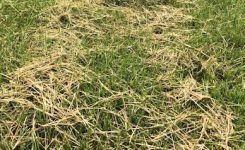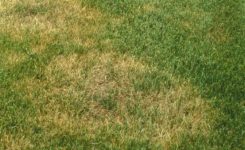Lawn Care Services, Lawn Treatment Solutions Blog
Are You Trying to Grow Grass Where Grass Won’t Grow?
Are You Trying to Grow Grass Where Grass Won’t Grow?
If you have thin grass or areas of grass that keep dying and nothing seems to help, there may not be enough sunlight on the lawn. Sunlight supplies the energy grass and other plants need to eat, drink, and breathe. This process is called photosynthesis. No amount of fertilization, irrigation, or core aeration will improve the grass if there is not enough sunlight to drive photosynthesis.
Without enough sunlight on the lawn, your grass will be weak and more susceptible to damage from temperature extremes, wear and tear, drought, pests, fungal disease, and other stressors.
Different grasses need different amounts of sunlight to thrive.
How much sunlight does my grass need?
Tall Fescue does very well with five to six hours of full sun exposure. Centipedegrass and Zoysiagrass need six to seven hours of sunlight. Bermudagrass needs at least eight hours of full sun with the exception of a couple of cultivars that may do well with six to seven hours.
What happens if you plant grass where there’s not enough sunlight?
Tall Fescue that is seeded in an area where there is insufficient sunlight may germinate and fill in relatively well during the fall. It will usually look okay through the spring, but will gradually become weaker and thinner as the summer progresses.
Warm-season grasses are generally more resilient than Tall Fescue in our climate zone, but only if they are getting their minimum required sunlight. Warm-season grasses are usually established as sod. When installed where there is insufficient sunlight, they may look good during the first summer but may become weaker or thinner the following spring when they have acclimated to their new environment.
How can I determine if shade is killing my lawn?
Do a sunlight assessment. A quick and easy place to begin the process of determining what is going on with a struggling area of your lawn is to literally count the hours of direct sunlight the area is getting in a day.
What you find might surprise you.
Observe the area that is thin about every hour on a sunny summer day, and tally up the hours when the area is fully exposed to sunlight. If there are fewer hours of sun exposure than your grass needs, then you have your answer as to why it is struggling. The fewer the hours of sunlight per day, the thinner the grass will be. If the minimum sunlight requirements are being met, then your lawn service provider should be able to help you figure out what is going on with soil testing and other assessments.
My grass used to be beautiful. Why is it so thin now?
Landscape environments change over time as new plants are added and existing plants grow.
The elm tree that was 20 feet high with virtually no canopy when it was planted in your front yard when your home was built may shade the entire front yard for most of the day 20 years later. The increasing amount of shade it creates year after year may initially prevent the soil from drying out, which would be beneficial for the grass. Eventually, the tree may create more shade than your grass can handle, and then the grass will not do as well.
What are my options for areas where there is insufficient sunlight?
One option is to remove trees or large shrubs that are creating the shade. Although this can be costly, it may be the only option for a lush and healthy lawn in the areas that are not getting a sufficient amount of sunlight.
Another option is to convert to a turfgrass that requires less sunlight (e.g., from Bermudagrass to Tall Fescue), but do an earnest sunlight assessment to be sure this option will work going forward as your trees and shrubs continue to grow.
A third option is to redesign your landscape to work with the amount of sunlight exposure. There are many wonderful plants that require less sunlight than turfgrasses. Consider planting some of them where turfgrass struggles. Patios and pathways add a lot of aesthetic value and functionality to a landscape, and they are lower maintenance than grass or other plants. If you are not the gardening type, you can get some help from a landscape designer.
In summary, when the type of grass you have requires more sunlight than it gets on a daily basis, it’s never going to be lush and healthy. However, there are options for working around the situation.








